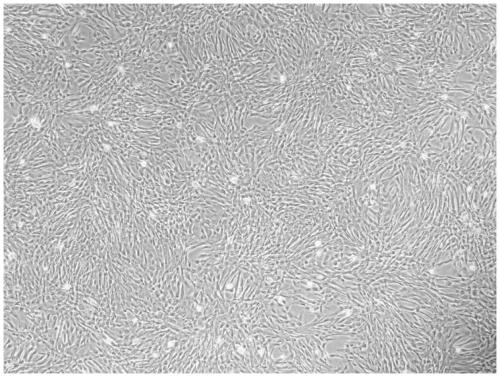Method for separating and extracting amniotic membrane stem cells from placentas
A technology for stem cells and amniotic membrane, which is applied in the field of separating and extracting amniotic membrane stem cells from placenta, can solve the problems of increased production cost of amniotic membrane stem cells, low extraction rate of neural stem cells, complicated separation methods, etc., and achieves simple and fast processing steps and realizes waste utilization. , the effect of prolonging the acquisition time
- Summary
- Abstract
- Description
- Claims
- Application Information
AI Technical Summary
Problems solved by technology
Method used
Image
Examples
Embodiment 1
[0040] A method for separating and extracting amniotic stem cells from placenta, specifically comprising the following steps:
[0041] Step 1: Take out the placenta with sterile tweezers and place it on a sterile culture plate, wash the blood stains on the surface of the placenta with sterile distilled water containing penicillin and streptomycin, then rinse the placenta again with 0.9% normal saline, and then Cut a piece of amniotic membrane from the placenta after rinsing and transfer it to a new sterile plastic petri dish, and continue to wash the blood stains on the surface of the amniotic membrane with normal saline, in which penicillin and streptomycin The concentration is 100 units / mL.
[0042]Step 2: Cut the amniotic membrane washed in step 1 into 0.5-1cm 2 The small pieces of amniotic membrane were washed with normal saline, and then the washed small piece of amniotic membrane was transferred to a new sterile plastic petri dish and rinsed with normal saline until the...
Embodiment 2
[0056] Amniotic membrane stem cells were separated and extracted from the placenta according to the method of Example 1, the difference was that the digestion time in Step 5 and Step 9 was both 30 s, and the centrifuge in Step 11 was pre-cooled to 2°C.
Embodiment 3
[0058] The amniotic membrane stem cells were separated and extracted from the placenta according to the method of Example 1, the difference was that the digestion time in Step 5 and Step 9 was both 90 s, and the centrifuge in Step 11 was pre-cooled to 8°C.
[0059] According to the above-mentioned Example 1 about a method for isolating and extracting amniotic membrane stem cells from placenta, under the same conditions, the present invention randomly selects nine full-term placentas of 25-30-year-old puerperas to isolate and extract amniotic membrane stem cells, and The obtained amniotic membrane stem cells are collected with the Olympus CX41+DP20 digital camera for amniotic membrane stem cell data collection. The amniotic membrane stem cell data collected are as follows: Figure 1-9 shown.
[0060] From Figure 1-9 It can be seen that the amniotic membrane stem cells isolated from 9 different placentas are all in the shape of typical stem cells, which meet the inspection stand...
PUM
 Login to View More
Login to View More Abstract
Description
Claims
Application Information
 Login to View More
Login to View More - R&D
- Intellectual Property
- Life Sciences
- Materials
- Tech Scout
- Unparalleled Data Quality
- Higher Quality Content
- 60% Fewer Hallucinations
Browse by: Latest US Patents, China's latest patents, Technical Efficacy Thesaurus, Application Domain, Technology Topic, Popular Technical Reports.
© 2025 PatSnap. All rights reserved.Legal|Privacy policy|Modern Slavery Act Transparency Statement|Sitemap|About US| Contact US: help@patsnap.com



